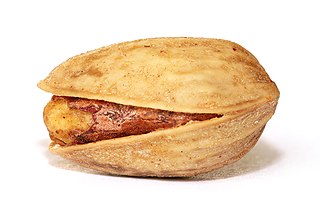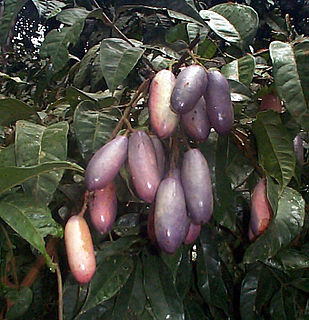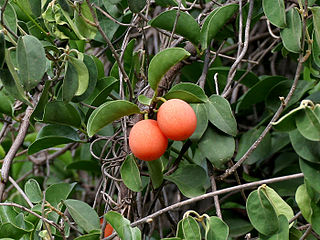Related Research Articles

The almond is a species of tree native to Iran and surrounding countries but widely cultivated elsewhere. The almond is also the name of the edible and widely cultivated seed of this tree. Within the genus Prunus, it is classified with the peach in the subgenus Amygdalus, distinguished from the other subgenera by corrugations on the shell (endocarp) surrounding the seed.

The pistachio, a member of the cashew family, is a small tree originating from Central Asia and the Middle East. The tree produces seeds that are widely consumed as food.

A plum is a fruit of some species in Prunus subg. Prunus. Mature plum fruits may have a dusty-white waxy coating that gives them a glaucous appearance. This is an epicuticular wax coating and is known as "wax bloom". Dried plums are called prunes, which have a dark, wrinkled appearance.

In botany, a drupe is an indehiscent fruit in which an outer fleshy part surrounds a single shell of hardened endocarp with a seed (kernel) inside. These fruits usually develop from a single carpel, and mostly from flowers with superior ovaries.

The sunflower seed is the seed of the sunflower. There are three types of commonly used sunflower seeds: linoleic, high oleic, and sunflower oil seeds. Each variety has its own unique levels of monounsaturated, saturated, and polyunsaturated fats. The information in this article refers mainly to the linoleic variety.

A prune is a dried plum, most commonly from the European plum. Not all plum species or varieties can be dried into prunes. A prune is the firm-fleshed fruit (plum) of Prunus domestica varieties that have a high soluble solids content, and does not ferment during drying. Use of the term "prune" for fresh plums is obsolete except when applied to varieties of plum grown for drying.

Prunus is a genus of trees and shrubs, which includes the fruits plums, cherries, peaches, nectarines, apricots, and almonds.

Vitellaria paradoxa, commonly known as shea tree, shi tree, or vitellaria, is a tree of the family Sapotaceae. It is the only species in the genus Vitellaria, and is indigenous to Africa.

Prune juice is a fruit juice derived from prunes that have been rehydrated. It is a mass-produced product that is often produced using a hot extraction method, and juice concentrate is typically produced using a low-temperature extraction method. It is used by some as a dietary supplement to act as a laxative and to alleviate constipation. It is also sometimes used as a flavor enhancer in tobacco products. It is an ingredient in many cocktails, such as the Purple Dragon, Constipolitan, Go with the Flow, Bowel Banger, Old Yeller, Pile Driver, and Smooth Move.

Spondias mombin, also known as yellow mombin or hog plum is a species of tree and flowering plant in the family Anacardiaceae. It is native to the tropical Americas, including the West Indies. The tree was introduced by the Portuguese in South Asia in the beginning of the 17th century. It has been naturalized in parts of Africa, India, Nepal, Bangladesh, Sri Lanka, The Bahamas, Indonesia, and other Caribbean islands. It is rarely cultivated except in parts of the Brazilian Northeast.

Macadamia oil is the non-volatile oil collected from the nuts of the macadamia, a native Australian plant. It is used in food as a frying or salad oil, and in cosmetic formulations as an emollient or fragrance fixative.

Astrocaryum murumuru is a palm native to Amazon Rainforest vegetation in Brazil, which bears edible fruits. Murumuru butter, extracted from the seeds of the plant, may be used as a moisturizer.

Dacryodes edulis is a fruit tree native to Africa, sometimes called safou (Cameroon), atanga, ube (Nigeria), African pear, bush pear, African plum, nsafu, bush butter tree, or butterfruit.

Marula oil is extracted from the kernels (nuts) of the fruits of the Marula trees, from the family Anacardiaceae. There are two types of marula oil, the oil extracted from the seeds and the oil extracted from the nut's hard shell. Marula oil is traditionally used in cosmetics, in food as a cooking oil, and as a meat preservative and to treat leather.

Ximenia americana, commonly known as tallow wood, hog plum, yellow plum, sea lemon, or pi'ut (Chamorro), is bush-forming shrub/small tree; a species from the Ximenia genus in the Olacaceae family. It is commonly found in woodlands native to the tropics in Africa, Asia, America and Australia, and grows to a height of 7m. Its leaves are borne on spur shoots and have a spear-like to oval shape. The flowers and fruit of X. americana are aromatic and small. Flowering mainly occurs during the dry season, however, the maturing and ripening of the flowers and fruits occur throughout the year and are not affected by climatic conditions.

Neochlorogenic acid or is a natural polyphenolic compound found in some types of dried fruits and a variety of other plant sources such as peaches. It is also found in Sunflower seed meal, Globe artichoke heads, Chicory [Red], Half-highbush blueberry, Highbush blueberry, Lovage, Burdock root, and Highbush blueberry. It is an isomer of chlorogenic acid; both of these are members of the caffeoylquinic acid class of molecules.
Vateria indica oil is extracted from the seeds of the Vateria indica plant, a species in the family Dipterocarpaceae. The Vateria indica plant is indigenous to the Western Ghats, Kerala and Tamil Nadu regions of India. It thrives in the evergreen forests, surviving up to 800 meters above sea level. Oil from the seeds of the plant is extracted through a chemical refining process which makes the plant edible.
References
- ↑ "Example of innovation support: virgin prune kernel oil". Archived from the original on May 13, 2006.